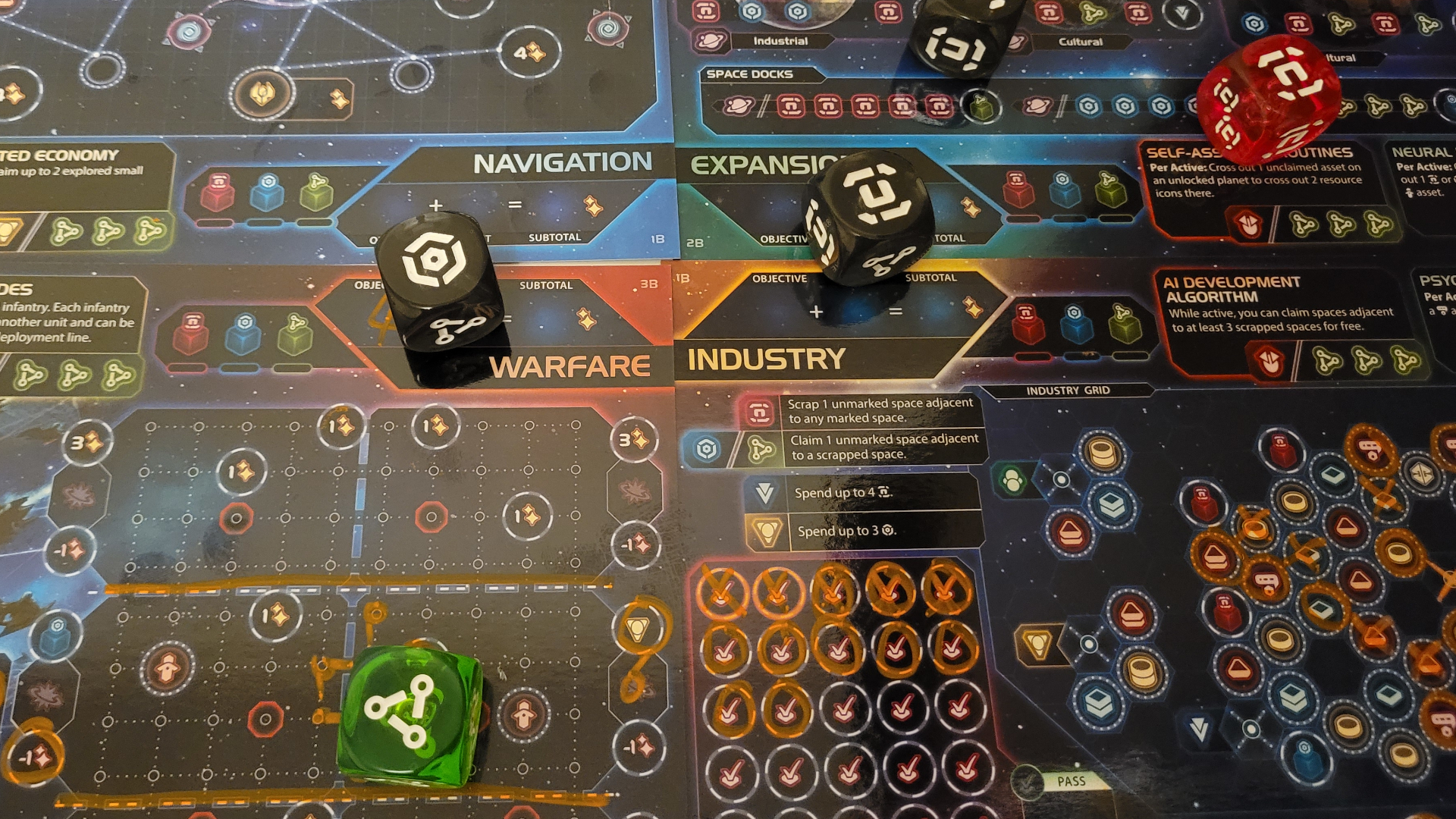GamesRadar+ Verdict
So long as you aren't expecting a stripped-down version of Twilight Imperium, this roll and write is strangely alluring. Some may find that it lacks tactical bite, but Twilight Inscription is a fascinating puzzle to solve nonetheless as you work to become master of the universe.
Pros
- +
Roll and write on a truly staggering scale with some genuine player interaction
- +
Multiple pathways to explore and routes to victory
- +
Huge number of options gives players big strategy levers to work with
Cons
- -
Awful 'quick start' rules and a confusing plethora of icons
- -
Isn’t much like Twilight Imperium at all
Why you can trust GamesRadar+
Twilight Inscription has a lot to live up to; the original game that inspired it, Twilight Imperium, is a behemoth in tabletop. Across four editions it’s challenged players with all-day sessions of deep space exploration and conquest, complete with political and technological dimensions. Despite its colossal complexity and play time, it’s well-loved enough that its shallow sci-fi setting has been ported to other titles such as Rex: Final Days of an Empire. Now it’s also the subject of one of the most unlikely ports in gaming history: a truly titanic franchise crashing into the fast, accessible genre of roll and write titles.
What is it, and how does it work?

- Game type: Roll and write
- Players: 1 - 8
- Complexity: Hard
- Lasts: 90 - 120 mins
- Ages: 14+
- Price: $64.99 / £64.99
- Play if you enjoy: Rawr N Write, Cartographers
At their core, roll and write games are exactly what they sound like - you roll dice to simulate a challenge and write down the result. Twilight Inscription follows this formula, but with significantly upped ante.
Most roll-and-write games use one sheet for players to keep track of the game state. The more in-depth ones use two. Twilight Inscription has no less than four for every player. They’re double-sided so you can choose whether all the players have the exact same setup, or whether they’re all following different sets of maps and charts for a diverse experience. In addition, players get a 'faction' card with an always-on special power and another they can activate if they claim it on one of their sheets.
These four sheets represent your exploration of the galaxy, your military fleets, individual planets under your control, and your overall industry. Each has some technology upgrades you can research. Otherwise, choosing to spend icons on a sheet generally involves crossing off boxes to gain resources. Some of these are abstract, but others are more concrete (such as council members to gain votes or starships to add to your fleets).
It's not just record-keeping
While each sheet has its own rules, they are also interlinked. You can’t start crossing off items on a planet, for example, until you’ve explored and claimed it on your navigation sheet.
In short, all these sheets have strong elements of spatial planning. When you cross off all the icons to build a starship, for instance, you have to draw its pattern on a deployment chart. This involves trying to draw around forbidden 'anomaly' spaces while trying to claim bonus points and population spaces. In industry, you have a choice of scrapping or claiming any space on the grid, but you can only claim spaces adjacent to the ones you’ve scrapped. It's not just record-keeping.

To spice things up even more, every sheet in Twilight Imperium has an associated objective as well. This is drawn randomly and awards points for completion, with a bonus if you’re the first to meet it. Much like board games for adults such as Wingspan, you're then sent scrambling after that bonus.
Similarly, there’s a deck of twenty-five cards to contend with - one for each round in the game. Most of these are strategy cards which feature icons players can use on one of their sheets. Others initiate wars, where you compare your strength against neighbouring players. There's the [X] symbol to contend with too, where players all vote to pass or fail an effect from a card.
Gameplay - is it any good?

Your first reaction to Twilight Inscription is likely to be one of total confusion. That might be because you naively tried to use the quick-start rules which are worse than useless, a mechanistic walk-through that fails to explain the point of any of what you’re doing. The full rulebook is far clearer and less complex than you might imagine, but even after reading that, it’s not immediately obvious what any of the dozen or so icons represent, let alone do, let alone how you actually get any of them.
But the four shiny black sheets spread before you with their luminous icons are strangely alluring. So is the chalk marker in your hand, an expensive upgrade over the usual dry-wipe pens that makes you feel like you’re marking up a futuristic tac-map with every line and circle you inscribe. And with nothing else for it, you take in the first strategy cards and try to decide where to spend those free icons before the dice are rolled.
Handling other players is just another variable on the intergalactic highway to becoming the master of the universe
Straight away, things become interesting. You may not want to spend all the icons on the card. If you want to focus on industry, for instance, they might all let you scrap spaces rather than claim them. But you don’t know what the dice are going to roll, and you have to spend them on the same sheet. So if you pick navigation instead you might end up exploring planets but have no chance to claim any. With four sheets to choose from you can certainly figure out how to get the most tactical benefit from each turn, but the question is whether that’s also getting you the most strategic benefit.
Doing that requires thinking about the long game, and thinking about the long game means learning and judging how the icons on those four sheets link together. All of them have roughly the same amount of points to extract, so there’s a huge number of ways to go about that extraction to maximise your score. Part of the framework is provided by the dice rolls, the random objectives, and your faction powers, many of which lean into particular approaches. Basically, every game is a new, dynamic puzzle to solve with a bewildering number of variables to challenge you.

As roll and write games go, it’s also surprisingly interactive. Winning wars isn’t such a huge deal in this regard. You can try and keep up with the military totals of your neighbours, but failing to do so just means a few lost resources and victory points; it’s not zero-sum where what one player loses is gained by another. No, the big interactive engine is the council votes. These involve drawing a random motion that has a specific pass-or-fail effect which will benefit some players and damage others depending on how their strategies are evolving. Then you use votes you’ve gained to support or oppose the motion. It’s an exciting moment that can have a big impact on how the game unfolds.
What it isn’t, however, is Twilight Imperium. Without armadas to manoeuvre across the map, without the mystery of a flip-tile map to explore, without the edge of untrustworthy diplomacy, it doesn’t feel like the same game at all. While it’s interactive for a roll and write, it’s not remotely interactive compared with even the tamest tactical skirmish or auction game. Nor does it generate much in the way of memorable narrative. It is, rather, a gigantic optimisation exercise with a constant flow of random inputs to keep it tantalisingly fresh with every turn of every play. Handling other players is just another variable on the intergalactic highway to becoming the master of the universe.
Should you buy Twilight Inscription?
So long as you’re not coming here expecting a stripped-down, more accessible version of the original game, there’s a lot to enjoy about Twilight Inscription. Some may find it a bit tame compared with full-on conflict games, while others may feel there’s a bit too much going on to really grasp and improve as a strategic exercise over repeat games. But if you feel like putting your head down and getting intimate with a chalk marker and more icons than you’ve ever seen in your life before, this delivers on a suitably epic scale.
Matt is a freelance writer specialising in board games and tabletop. With over a decade of reviews under his belt, he has racked up credits including IGN, Dicebreaker, T3, and The Guardian.




